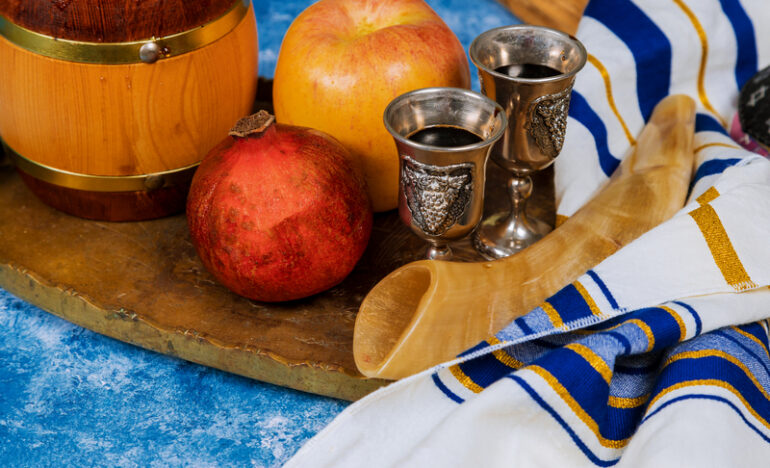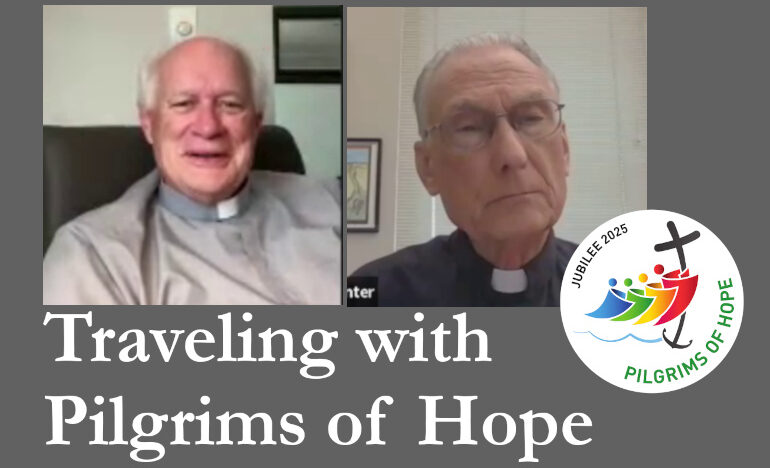Celebration of Rosh Hashanah: A Time of Repentance and Renewal

By Kathy Keary
Our full series on Contemplative Life is here.
Our new series on Judaism and Contemplation is here.
The Jewish holidays of Rosh Hashanah, followed ten days later by Yom Kippur, occurs in September each year. We will begin our series on the contemplative ways of Judaism with an exploration of these sacred days.
These days are called the “High Holidays,” or “High Holy Days.” Typically, Jewish holidays commemorate an historic event or a transition in nature; however, Rosh Hashanah and Yon Kippur focus on one’s relationship with God (Falcon, 257).
Rosh Hashanah, a solemn time, is known as the Jewish New Year and is often referred to as Yom Ha-Zikaron (The Day of Remembrance) and Yom-Ha-Din (The Day of Judgement.) A Jewish text, the Talmud, metaphorically describes this time of judgement by saying that on this day, God opens three books. Inscribed in the Book of Death are the names of the totally wicked. Written in the Book of Life are those who are completely righteous. Then there is the book for those who fall in between sometimes being righteous and at other time falling short. Judgement for this final group is saved for Yom Kippur. A positive result is more likely when one engages in acts of charity, heartfelt repentance, and prayer.
Rosh Hashanah is a time for deep self-reflection – a time to review the past year calling to mind one’s transgressions. This is a time to experience the merciful nature of our God, but to do so, one needs to acknowledge their failings and make amends were applicable. Rabbi Ted Falcon advises that this special day “arrives like a wake-up call just before winter, offering a chance to renew and refresh your intentions, your priorities, and your sense of Spiritual connectedness” (Falcon, 258 – 260).
Judaism understands a review of one’s life is an extensive exercise impossible to complete with sincerity in one day. For this reason, the month preceding Rosh Hashanah, called Elul, is dedicated to study and self-examination. Most mornings during Elul, Jews blow a ram’s horn known as a shofar at the synagogue serving as a wake-up call to the soul.
Psalm 27 is read each day during Elul. This passage references an enemy which rabbis generally consider to be the enemy within one’s heart described by Falcon as “the parts of oneself that works from a place of forgetfulness, ignorance, fear, or anger.” The psalm assures that Adonai (God) will be the source of strength in times of such challenge.
Note: Never miss an article published on the Renewal Center website: Sign up to receive our newsletters.
During the month of Elul, a series of prayers called s’lichot is included in the Jewish service which is a cry to God asking for forgiveness. The Saturday night before Rosh Hashanah a s’lichot service is held when tradition says the heavens are especially opened to prayers. It’s not uncommon for a Jewish person to reach out to others at this time to ask for or offer forgiveness seeking reconciliation for the failures of that year (Falcon, 261).
The Rosh Hashanah celebration begins with the lighting of candles and reciting two blessing at sundown typically at home. Then the Jewish people travel to the synagogue for a service. The Torah, the reading table, and the curtain of the ark are covered with white symbolizing purity. Most participants wear white as well and dress in their finest clothes. It’s quite common to eat sweets after the service toasting to a good and sweet year. They typically attend the service both in the evening and the next day. Then they repeat the service for a second day with a few changes to the readings.
The readings focus on three themes:
- Malkhiyot (Kingship): They pray to God as King focusing on the majesty of God in the world.
- Zikhronot (Remembrance): They ask God to remember humanity during this time and pray that people will remember all that God has done for us.
- Shofarot (Shofar blasts): These prayers focus on the Torah and Zion, the Promise Land (Falcon 264).
It’s commonplace for the story of Abraham sending away Hagar and Ishmael to be read on the first morning. On the second morning, the story of Abraham’s near sacrifice of Isaac is read. These stories encourage the listener to ponder the meaning of faith as they begin a new year. The stories highlight Abraham’s commitment placing the lives of both of his children in God’s hands (Falcon, 265).
The shofar is blown one-hundred times during the service. It is viewed as a way to alert people to the need to wake up and turn their lives around. Some see it as penetrating the shell that has hardened their hearts in the prior year (Falcon, 266).
The meaningful theme of reconciliation and renewal is not peculiar to Judaism. This focus is found in many of the faith traditions of the world.
Stay tuned for our next article where we will explore the ten days following Rosh Hashanah and the holiday of Yom Kippur.
Reference
Falcon, Ted and Blatner, David. Judaism for Dummies. Hoboken, New Jersey: John Wiley and Sons, Inc, 2019.
Kathy Keary, a Precious Blood Companion and spiritual director, holds a Master’s Degree in Theological Studies and is a graduate of the Atchison Benedictines Sophia Center’s Souljourners Program, an intense study of spirituality and spiritual direction. Kathy believes that the Divine is present and active in all of life and encourages others to be awakened to the God in all including the divine within. She enjoys accompanying others on their journey to wholeness discovering the person they were created to be.
We’d Like to Hear from You!
We’d like to know what you think about this article. Send us a comment using the form below. Do you have a suggestion? Is there something you want to learn more about? Send us a note.
Related

Do You Hear What I Hear?
By Fr. Garry Richmeier, C.PP.S.
How can we avoid the harmful affects of the polarization that characterizes so much of our lives these days? One step toward this end is to cultivate a greater understanding and appreciation for the idea of relativity in human behavior.

Pilgrims of Hope, Episode 9: Walking with Deacons of Hope
In this episode, Fr. Ron Will talks with Deacon Kevin Cummings from the Kansas City, Kansas, archdiocese. He and a fellow deacon founded the organization Deacons of Hope, a parish-based, nonprofit, pro-life ministry for permanent deacons.
Categories
Assembling God's Puzzle Coffee with Padre Cooking & Spirituality Encounters of the 4th Kind Family Matters Reflections on the Eucharsitic Prayers Spiritual Resources Taize Prayers The Contemplative Life Traveling with Pilgrims of Hope Uncategorized Videos Week of Prayer for Christian Unity When you need a little help
